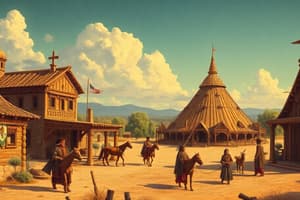Podcast
Questions and Answers
What type of agricultural practice is commonly utilized by indigenous tribes in Mindanao?
What type of agricultural practice is commonly utilized by indigenous tribes in Mindanao?
- Monoculture farming
- Swidden agriculture (correct)
- Hydroponics
- Intensive conventional farming
What role do leaders known as 'Datu' play in the indigenous communities of Mindanao?
What role do leaders known as 'Datu' play in the indigenous communities of Mindanao?
- They make decisions for the community. (correct)
- They manage all agricultural practices.
- They serve as military commanders.
- They are the primary spiritual guides.
Which musical instruments are traditionally used by indigenous tribes in Mindanao?
Which musical instruments are traditionally used by indigenous tribes in Mindanao?
- Guitar and piano
- Trumpet and saxophone
- Drums and maracas
- Kulintang and agong (correct)
What is a major challenge faced by indigenous tribes in Mindanao today?
What is a major challenge faced by indigenous tribes in Mindanao today?
How do indigenous tribes in Mindanao typically express their cultural identity?
How do indigenous tribes in Mindanao typically express their cultural identity?
Which of the following is NOT a reason for the cultural preservation efforts among indigenous tribes in Mindanao?
Which of the following is NOT a reason for the cultural preservation efforts among indigenous tribes in Mindanao?
Which of the following artistic expressions is NOT commonly associated with indigenous tribes in Mindanao?
Which of the following artistic expressions is NOT commonly associated with indigenous tribes in Mindanao?
What belief system do many indigenous tribes in Mindanao adhere to that involves spirits in nature?
What belief system do many indigenous tribes in Mindanao adhere to that involves spirits in nature?
Flashcards are hidden until you start studying
Study Notes
Cultural Heritage Of Indigenous Tribes in Mindanao
-
Diversity of Indigenous Tribes
- Mindanao is home to various indigenous groups, including the Lumad, Moro, and other ethnic communities.
- Each tribe has its own unique language, customs, and traditions.
-
Traditional Practices
- Art and Craft: Weaving, beadwork, wood carving, and metalwork are prominent artistic expressions.
- Music and Dance: Traditional music features indigenous instruments like the kulintang and agong; dances often depict stories of daily life and rituals.
-
Beliefs and Spirituality
- Many tribes practice animism, believing in spirits inhabiting natural elements.
- Rituals and ceremonies are conducted to honor ancestors and seek blessings from spirits.
-
Social Structure
- Tribes often have a communal structure with leaders called "Datu" who make decisions for the community.
- Family ties and kinship are paramount, influencing social interactions and responsibilities.
-
Agricultural Practices
- Indigenous tribes utilize sustainable farming techniques, often practicing swidden agriculture (slash-and-burn).
- They cultivate crops like rice, corn, and root crops, and utilize forest resources for food and medicine.
-
Cultural Preservation
- Many tribes are actively involved in efforts to preserve their cultural heritage through education, festivals, and social movements.
- Challenges include modernization, land disputes, and the impact of external influences on traditional practices.
-
Role of Festivals
- Festivals celebrate cultural identity, featuring traditional music, dances, and rituals.
- Examples include the Kandingan Festival and the Lumad Mindanao Festival.
-
Challenges and Issues
- Indigenous tribes face socio-economic challenges, land displacement, and cultural erosion.
- Advocacy for indigenous rights and recognition of ancestral domains is crucial for cultural preservation.
-
Cultural Exchanges
- Mindanao’s cultural heritage has been shaped through interactions with other cultures, including Malay, Chinese, and Spanish influences.
- This has led to a rich tapestry of traditions, blending indigenous practices with external influences.
-
Contemporary Relevance
- Understanding and promoting the cultural heritage of indigenous tribes in Mindanao is essential for national identity and historical acknowledgment.
- Indigenous knowledge systems contribute to biodiversity conservation and sustainable development.
Diversity of Indigenous Tribes
- Mindanao hosts a variety of indigenous groups, including Lumad, Moro, and other ethnic communities.
- Each tribe possesses its own distinct language, customs, and traditions.
Traditional Practices
- Art and Craft: Dominant forms include weaving, beadwork, wood carving, and metalwork, showcasing the tribes' artistic skills.
- Music and Dance: Indigenous music utilizes instruments such as the kulintang and agong; dances narrate stories from daily life and cultural rituals.
Beliefs and Spirituality
- Animism is widely practiced, with tribes believing in spirits that inhabit nature.
- Rituals are performed to honor ancestors and request blessings from spirits.
Social Structure
- Community decisions are led by a "Datu," reflecting a tribal leadership system.
- Strong family bonds and kinship govern social interactions and responsibilities.
Agricultural Practices
- Sustainable farming techniques are employed, especially swidden agriculture (slash-and-burn).
- Key crops include rice, corn, and root vegetables, while forest resources are used for food and medicine.
Cultural Preservation
- Indigenous groups actively engage in preserving their heritage through education, festivals, and activism.
- Major challenges include modernization, land disputes, and the impact of external cultural forces on traditional ways.
Role of Festivals
- Festivals serve as a celebration of cultural identity, featuring traditional music, dance, and rituals.
- Notable examples include the Kandingan Festival and the Lumad Mindanao Festival.
Challenges and Issues
- Indigenous tribes experience socio-economic hardships, land dispossession, and cultural erosion.
- Advocacy for indigenous rights and the acknowledgment of ancestral domains is vital for heritage preservation.
Cultural Exchanges
- Mindanao's cultural heritage is influenced by interactions with Malay, Chinese, and Spanish cultures.
- This mixing has produced a rich blend of traditions, merging indigenous practices with external influences.
Contemporary Relevance
- Promoting the cultural heritage of indigenous tribes is crucial for national identity and historical recognition.
- Indigenous knowledge systems play a role in biodiversity conservation and sustainable development efforts.
Studying That Suits You
Use AI to generate personalized quizzes and flashcards to suit your learning preferences.




